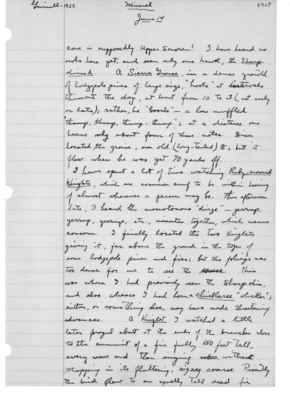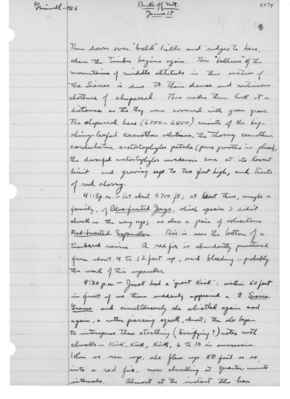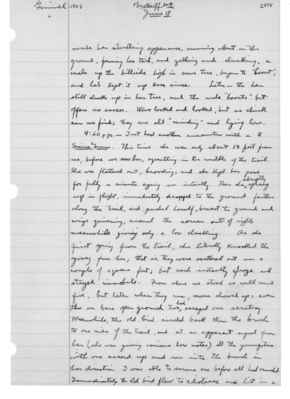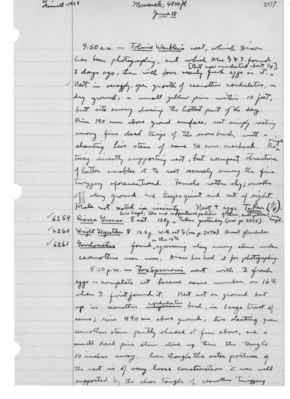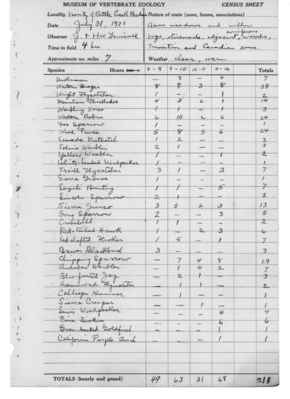Pages That Mention Sierra Grouse
1925: Joseph Grinnell's field notes
S2 Page 8
Collector: Grinnell - 1925 Location: Lassen Section (Mineral) Date: June 14, 1925 Page Number: 2464
zone is supposedly Upper Sonoran! I have heard no owls here yet, and seen only one hawk, the Sharp shinned. A Sierra Grouse, in dense growth of lodgepole pines of large size, "hoots" at intervals thruout the day, at least from 10 to 3 (not early or late); rather, he "boonts" - a low muffled "thump, thump, thump, thump"; at a distance one hears only about four of these notes. Dixon located the grouse, an old (long-tailed) female, but it flew when he was yet 70 yards off. I have spent a lot of time watching Ruby-crowned Kinglets, which are common enuf to be within hearing of almost wherever a person may be. This afternoon late, I heard the monotonous "dinge", yerrup, yerrup, yerrup, etc., minutes together, which means concern. I finally located the two Kinglets giving it, far above in the tops of some lodgepole pines and firs; but the foliage was too dense for me to see the cause. This was where I had previously seen the Sharpshin, and also whence I had hear a chickadee "chicken"; either, or something else, may have made threatening advances. A Kinglet I watched a little later foraged about at the end of branches close to the summit of a fir fully 150 feet tall, every now and then singing without stopping it its fluttering, zigzag course. Presently the bird flew to an equally tall dead fir
S2 Page 19
Collector: Grinnell - 1925 Location: Lassen Section (Brokeoff Mt.) Date: June 17, 1925 Page Number: 2474
Then down over "bald" hills and ridges to here, where the Timber begins again. This "baldness" of the mountains of middle altitude in this section of the Sierras is due to their dense and continuous clothure of chaparral. This makes them look at a distance as tho they were covered with green grass. The chaparral here (6000-6500) consists of the big shiny-leafed ceanothus velutinus, the thorny ceanothus condulatus, arctostaphylos patula (pure growths in places), the dwarfed arctostaphylos nevadensis here at its lowest limit and growing up to two feet high, and tracts of red cherry. 4:15 p.m. - At about 6700 ft.; at least there, maybe a family, of Blue-fronted Jays, which species I didn't check on the way up; as also a pair of solicitous Red-breasted Sapsuckers. This is near the bottom of a timbered ravine. A red fir is abundantly punctured from about 4 to 12 feet up, and bleeding - probably the work of this sapsucker. 4:30 p.m. - Just had a "great kick": within 50 feet in front of us there suddenly appeared a female Sierra Grouse and simultaneously she whistled again and again, a rather piercing squall, almost; then she began to intersperse these startling (terrifying?) notes with clucks - kirk, kirk, kirk, 6 to 10 in succession. When we ran up, she flew up 80 feet or so into a red fir, now clucking at quarter-minute intervals. Almost at the instant the hen
S2 Page 20
Author: Grinnell-1925 Location: Lassen Section (Brokeoff Mt.) Date: June 17, 1925 Page Number: 2475
made her startling appearance, running about on the ground, fanning her tail, and yelling and clucking, a male up the hillside high in some tree, began to "boont", and he's kept it up ever since. Later - the hen still clucks up in her tree, and the male "boonts" but offers his succor. We've looked and looked, but no chick can we find; they are all "(unknown2)" and lying low. 4:50 p.m. - Just had another encounter with a female Sierra Grouse. This time she was only about 12 feet from us, before we saw her, squatting in the middle of the trail. She was flattened out, brooding; and she kept her pose for fully a minute eyeing us intently. Then she abruptly sprung up in flight, immediately dropped to the ground farther along the trail, and pushed herself, breast to ground and wings quivering, around the corner out of sight, meanwhile giving only a low clucking. As she first sprung from the trail, she literally knocked the young from her; that is, they were scattered out over a couple of square feet; but each instantly froze, and stayed immobile. From where we stand we could count five, but later when they ran, seven showed up: even tho on bare open ground two had escaped our scrutiny. Meanwhile, the old bird circled back thru the brush to one side of the trail, and at at an apparent signal from her (she was giving various low notes) all the youngsters with one accord up and ran into the brush in her direction. I was able to secure one before all had vanished. Immediately the old bird flew to a distance and lit in a
S2 Page 22
Collector: Grinnell-1925 Location: Mineral, 4800 ft. Date: June 18, 1925 Page Number: 2477
9:50 am -- Tolmie Warbler's nest, which Dixon has been photographing, and which Mrs. G & I found 3 days ago, then with four nearly fresh eggs in it. ^[But now incubated about 1/4.] Nest in scraggly, open growth of ceanothus cordulatus, in dry ground, a small yellow pine within 10 feet, but site sunny during the hottest part of the day. Rim 190 mm. above ground surface, nest snugly resting among five dead twigs of the snow birch, with a slanting live stem of same 80 mm. overhead. No single twig directly supporting nest, but compact structure of latter enables it to rest securely among the fine twiggery aforementioned. Female rather shy; sneaks off along ground and keeps quiet and out of sight. Male not noted in vicinity. Nest & eggs taken (1/4). 6259 Sierra Grouse (male) nat. 13.8g. ^Iris hazel; toes and unfeathered portions of tarsi, dull yellow; iris hazel. Taken yesterday (see p. 2475). 6260 Wright Flycatcher (female) 12.2g. With set 1/4 (see p. 2476). Breast glandular. 6261 Gerrhonotus found ^on the 16th squirming along among stems under ceanothus near mom; Dixon has had it for photographing. 5:10 p.m. -- Fox Sparrow's nest with 3 fresh eggs -- complete set because same number on 16th when I first found it. Nest not on ground but up in ceanothus integerrimus cordulatus bush, in large tract of same; rim 490 mm. above ground; two slanting green ceanothus stems partly shaded it from above, and a small dead pine stem stood up thru the tangle 10 inches away. Even though the outer portion of the nest is of very loose construction it was well supported by the close tangle of ceanothus twiggery
S2 Page 86
| MUSEUM OF VERTEBRATE ZOOLOGY | CENSUS SHEET |
| Locality: Vicinity of Battle Creek Meadows | Nature of Route(zone,fauna, associations): |
| Date: July 31, 1925 | Across meadows and willow |
| Observer: J. & H.W. Grinnell | bogs, streamside, adjacent ^coniferous woods; |
| Time in Field: 4 hrs. | Transition and Canadian zones |
| Approximate no. miles: 7 | Weather: clear, warm |
| Species Hours[arrow symbol pointing right] | 8-9 | 9-10 | 10-11 | 11-12 | Totals | |
| Unknown | - | 3 | - | 4 | 7 | |
| Western Tanager | 8 | 9 | 3 | 8 | 28 | |
| Wright Flycatcher | 1 | - | - | 1 | 2 | |
| Mountain Chickadee | 4 | 3 | 6 | 1 | 14 | |
| Warbling Vireo | 1 | 1 | 0 | 1 | 3 | |
| Western Robin | 6 | 10 | 2 | 6 | 24 | |
| Fox Sparrow | 1 | 0 | 0 | 0 | 1 | |
| Wood Pewee | 5 | 8 | 5 | 6 | 24 | |
| Canada Nuthatch | 1 | 2 | 0 | 0 | 3 |
TOTALS (hourly and grand)|49|63|31|68|211
